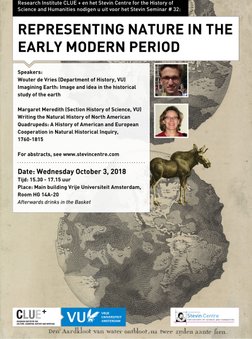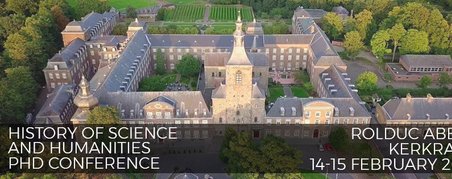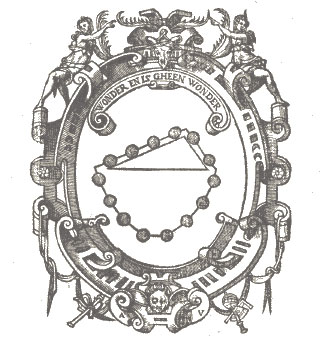Seminar #32
Date: Wednesday October 3 2018
Time: 15:30 - 17:15 hr.
Place: HG-14A-20
(VU Main Building, 14th floor)
Representing Nature in the early modern Period.

Summaries
Writing the Natural History of North American Quadrupeds:
A History of American and European
Cooperation in Natural Historical Inquiry, 1760-1815
Between 1760 and 1815, a large number of American quadrupeds came into existence, as it were, as identified and fully described species whose external appearance, anatomy, and physiology could be viewed, studied, and referenced in authoritative publications. This feat was the result of a plethora of naturalists and men of learning in both Europe and North America who endeavored for more than a half century to correct and add to the existing, incomplete, error ridden corpus of knowledge about quadrupeds. But it was Europeans, not Americans, who authored the majority of the new authoritative natural histories of these American quadrupeds. Historians of European natural history during this period have rarely asked how or why Europeans rather than Americans predominated as authors, given the distances involved and the challenges to their sovereignty in North America at the time.
This paper offers a glimpse into how this feat was accomplished and why Europeans dominated it using a few important and representative examples, including the Moose, the American Mammoth, later identified as the Mastodon, the first animal to be identified as extinct, and the Megalonyx, a huge extinct Sloth. It offers an explanation which does not rely on viewing Europe’s predominance in this feat as a product of America’s failure that historians of early America have long argued. Instead, it offers a more historicized account of the complexity of identification coupled with detailed accounts of how knowledge about these quadrupeds circulated between North America and Europe during this period. The result is one in which Americans prove to be robust and active participants in the European writing of natural histories of North American quadrupeds.
Imagining Earth
Image and idea in the historical study of the earth
The seventeenth century witnessed a surge of studies that deal with the interior, history and make-up of planet Earth. The lavishly illustrated Mundus Subterraneus by the Jesuit scholar Athanasius Kircher immediately springs to mind, but he is far from the only one. In the realms of theology, (biblical) history, mining, geography, alchemy or the study of fossils, natural philosophers and other specialists were exploring the different histories of the Earths creation, development and make-up. Over the course of roughly a century, the understanding of ‘Earth’ was changed radically. And while it would be tempting to frame this as a proto-geological development, it was in fact a much broader discussion.
Many of these authors employed images (prints) in their works, but this was not without problems. After all, how does one represent something that cannot be seen, and what does this mean for the ideas that are formulated? Looking at the interconnections between images and ideas on the historical earth reveals an interesting dynamic. On the one hand, the role and status of (scientific) images changed radically in this period, and the same holds true for prints representing the earth. On the other hand, these scientific images had an impact on the public imagination, changing not only the seventeenth- and eighteenth-century representation of the earth and its history and interior, but also what people believed to be representing.
This seminar will explore the different connections between images of and ideas on the (early) earth. Taking the Dutch biblical historian and art-theorist Willem Goeree (1635-1711) as a starting point, it will trace images through different disciplines and publications, and compare this to changes in ideas and conceptualizations of the Earth. By doing so, we can hope to understand how the seventeenth century mind learned to imagine an new worldview.
Wouter de Vries (1993) is PhD candidate at the department of Cultural History at the VU Amsterdam.
Call for papers: History of Science and Humanities PhD Conference
We cordially invite you to the 7th edition of the biennial History of Science and Humanities PhD Conference that will take place on the 14 and 15 February, 2019, at Rolduc Abbey, Kerkrade, Limburg.
The conference aims to bring together PhD candidates in Belgium and the Netherlands who work in the field of the history of sciences in the broadest sense: including histories of knowledge, technology, medicine, the natural sciences, the humanities, and the social sciences, spanning any time period. While we will discuss our work (and work-in-progress) in an informal and congenial setting, we will also plan to have plenty of time to get to know each other, as ‘intellectual networking’.
Conference Set-up
Each participating PhD candidate will be asked to give a 15-minute presentation about their work, with appropriate time afterwards for questions and discussion.
We would like to stress that all contributions are welcome, whether they are presentations of already finished chapters, broad outlines of the initial research plan or methodology, or maybe a specific case study that will play a major or minor part in your overall thesis.
The language of the conference will be English. To get an idea of the previous conference, see the reports on Shells and Pebbles and in Studium, written by participants.
Registration
You can register by sending an e-mail to Emma Mojet (g.e.n.mojet@uva.nl) by 21 November. Please include the university you are affiliated with, and a title and short abstract (approx. 250 words) of the work you would like to present. Notification of participation will be given by 15 December.
The participation fee for the conference will be €95. The fee will cover the overnight stay at the abbey, lunch on both days, a three-course dinner on Thursday, as well as coffee, tea, and cake. The conference is made possible thanks to the generous support of the Vossius Center for the History of Humanities and Sciences, the Descartes Centre for the History and Philosophy of the Sciences and the Humanities, and the Huizinga Institute.
For any further questions, feel free to contact us!
The conference organisers,
Sjang ten Hagen (s.l.tenhagen@uva.nl)
Emma Mojet (g.e.n.mojet@uva.nl)
Jaco de Swart (j.g.deswart@uva.nl)
Chaokang Tai (c.k.tai@uva.nl)


.jpg?etag=%222c95-5316427d%22&sourceContentType=image%2Fjpeg&ignoreAspectRatio&resize=117%2B67&extract=0%2B0%2B117%2B67&quality=85)
